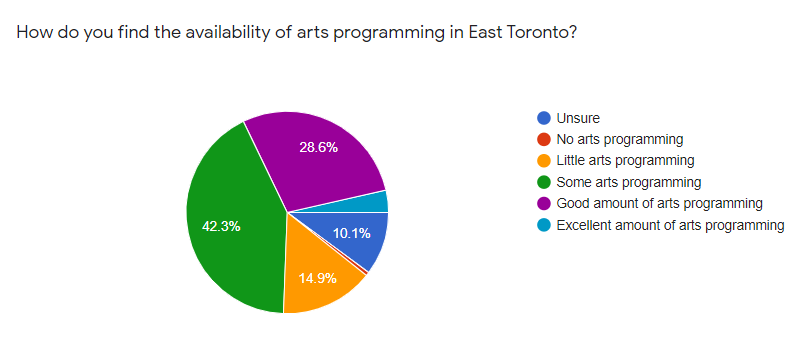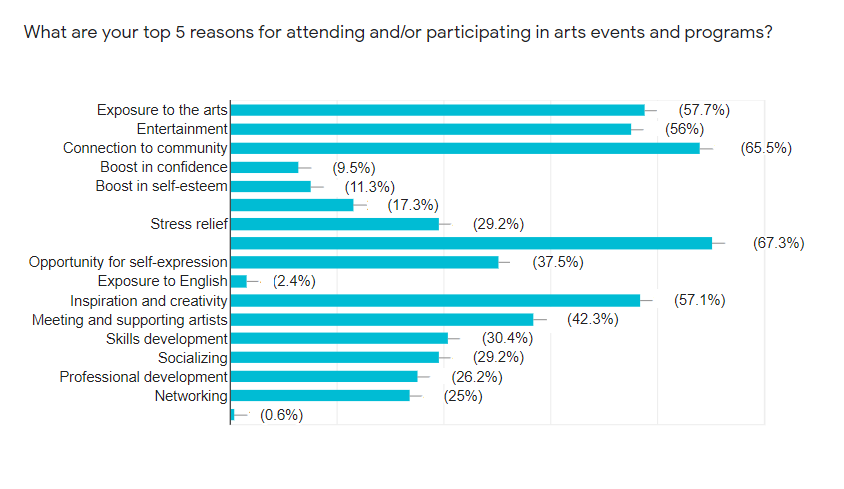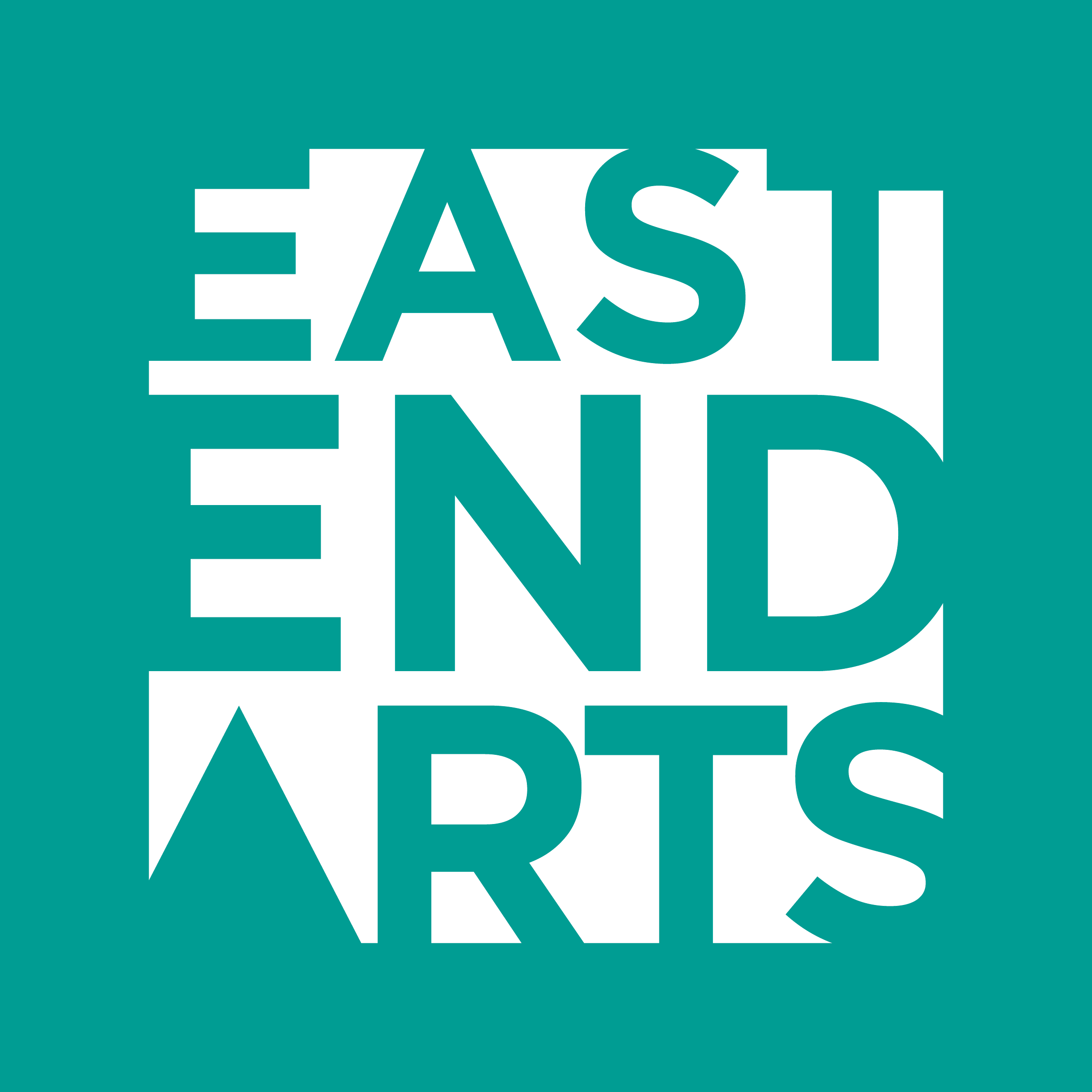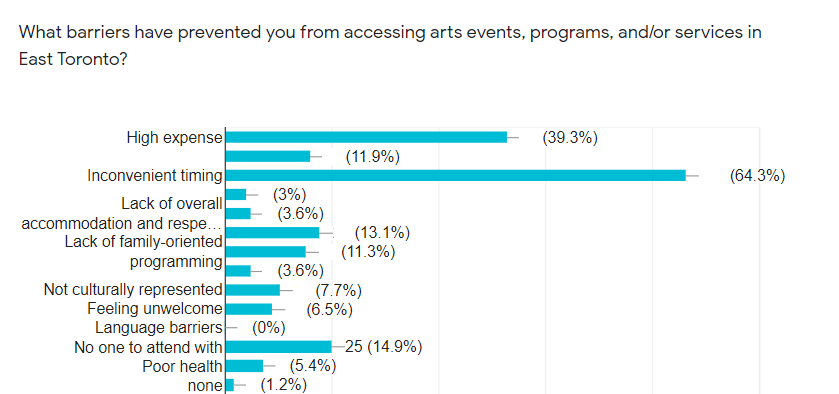Earlier this year, we conducted our second arts-audience survey to gather opinions from our east Toronto communities. While the outbreak of COVID-19 cut our survey window short, we received so much useful feedback! Read below to learn more!
As a seven-year-old nonprofit arts organization, we’d consider ourselves comfortably past the terrible twos, the troublesome threes, and even the frustrating fives, but seven means that we’re still growing and changing in lots of ways – and by the numbers in this year’s survey, our audiences are growing and changing too. Each year we refine our programs, we deepen our understanding of the citizens we serve, and we ultimately become more connected and woven into the identity of the east end of Toronto.
In 2018, we decided to launch our first ever audience survey to understand more about our audiences, their program preferences and how we could better serve them: enter in our 2018 Arts Audience Survey. This was the first larger scale survey that we had conducted, and it gave us our first snapshot of community members and artists in east Toronto, and their needs and wants from us, east Toronto’s Local Arts Service Organization.
This past winter in February of 2020, we launched our second 2020 Arts Survey to continue painting this picture of our audiences and the creative communities in east Toronto. Specifically, we wanted to understand a wider scope of our audiences on all our digital channels (not just our newsletter), and we wanted to see if there were any key changes within the community’s expectations or opinions of us within the last two years. While we had roughly the same number of respondents both years, there are some interesting key findings that we’d like to share with you all!
P.S. We are committed to conducting an Audience Arts Survey every second year, as we believe this is the best way to gather feedback from our east Toronto communities, and to help us grow and evolve well into the future (enraging enlightened eights, and nasty nicer nines, bring it on!)
Key Findings from our 2020 Arts Survey:
1. Members of east Toronto have some favourite places they like to consume arts and culture in the #EastEnd. In order from first to sixth:
- Evergreen Brickworks (57%)
- Outdoors / parks (55%)
- Danforth Music Hall (41%)
- Winter Stations (37%)
- Fox Cinema (30%)
- Crow’s Theatre (27%)
It’s exciting to see that so many of you were already excited about outdoor spaces and outdoor programming! Certainly since we’ve been trying to find ways to bring arts programming to our communities during a pandemic, we’ve been keenly aware of the importance of outdoor-art! From Shadowland Theatre’s recent performance at Dentonia Park, to the photography workshops we’ve been holding at TCHC buildings, to some exciting, upcoming performances in Riverdale Park East that you should watch our social media for, summer 2020 has seen a lot of awesome outdoor events to enjoy!
2. Members of east Toronto also have some favourite go-to arts and culture venues outside the #EastEnd. These included, from first to fourth:
- Art Gallery of Ontario (89%)
- Royal Ontario Museum (80%)
- Nuit Blanche (67%)
- Mirvish Theatre Productions (50%)
Our commitment to continue bringing a Nuit Blanche hub to east Toronto may help to shift these results, so that Nuit Blanche soon becomes a favourite go-to spot inside east Toronto! Fun fact: this year, our Toronto Mycelial Network project will be listed as part of the amazing collection of digital programs that our partners at Nuit have put together for the fall of 2020.
3. How much arts programming is in east Toronto? 14.9% said that there is a little amount of arts programming in east Toronto; 42.3% said that there is some arts programming in east Toronto; and another 28.6% of respondents believe that there is a good amount of arts programming in east Toronto.
 While these numbers are not hugely disappointing, we can see that there is a lot of room to grow. This is an area we have been committed to addressing – bringing more arts and culture outside the downtown core. We also recognize that this could also be a case of simply letting people know about the awesome events and artists working in the catchment, i.e. perhaps it’s not so much a supply issue but a promotion issue. Our expanded East End Spotlights have been very popular since the pandemic started and have seen a lot of engagement. We’ve even seen new exciting artist collaborations that have come about directly from our spotlights – yay!
While these numbers are not hugely disappointing, we can see that there is a lot of room to grow. This is an area we have been committed to addressing – bringing more arts and culture outside the downtown core. We also recognize that this could also be a case of simply letting people know about the awesome events and artists working in the catchment, i.e. perhaps it’s not so much a supply issue but a promotion issue. Our expanded East End Spotlights have been very popular since the pandemic started and have seen a lot of engagement. We’ve even seen new exciting artist collaborations that have come about directly from our spotlights – yay!
4. When we asked survey respondents to tell us what they thought the greatest challenge facing east Toronto was, we had many great answers, and the majority of answers fell into three main categories:
-
- Reputational – i.e. east Toronto is perceived to be too far from the downtown core; a lack of advertising; a lack of a strong identity;
- Political/Racial – i.e. racial divides between established communities and newer communities; racist incidents and graffiti;
- Financial – i.e. availability of affordable housing; available and affordable studio space for artists and creators; increasing rent prices and gentrification.
We believe that continuing to strengthen the arts and culture in east Toronto is pivotal to building stronger, more resilient communities, and communities with a more unified sense of identity. Past programs, like our #EastEndLove project was created as a direct response to racist incidents in east Toronto. This year, we are happy that we’ve been able to expand the idea of #EastEndLove and the Black Lives Matter movement into one of the guiding themes of the #DestinationDanforth mural project. These survey results strengthened our commitment to continuing to do more projects like this: using art as a way to have difficult conversations and bring people together.
Similarly, our hub at St. Matthew’s Clubhouse has allowed and continues to allow us to offer subsidized rates to artists and community members, as we recognize the lack of affordable spaces in our communities. Survey results like these help to solidify that we are going in the right direction and need to continue doing this important work.
5. Not so surprising, there were 5 top reasons that people identified with for attending and/or participating in arts events and programs:
-
- Learning new things and engaging in new experiences (67%)
- Connecting to community (65%)
- Exposure to the arts (58%)
- Inspiration and creativity (57%)
- Meeting and supporting artists (43%)
 These results seem right on the money. If we’ve seen anything in the pandemic it’s been that people are hungry for learning new things, making and creating, (the run on art supplies, home design materials and flour for making sourdough is proof of that!), and are desperate to find ways to connect to their communities through things like online performances, social dancing and online cocktail hours. People are looking for inspiration and opportunities to be creative and where they can they’ve been enormously interested in and generous in their support of artists.
These results seem right on the money. If we’ve seen anything in the pandemic it’s been that people are hungry for learning new things, making and creating, (the run on art supplies, home design materials and flour for making sourdough is proof of that!), and are desperate to find ways to connect to their communities through things like online performances, social dancing and online cocktail hours. People are looking for inspiration and opportunities to be creative and where they can they’ve been enormously interested in and generous in their support of artists.
6. When asked what our communities would like to see us do more of, they replied:
- Arts workshops for adults & seniors (60%)
- Murals & installations (57%)
- Live Music events (52%)
- Professional Development Workshops (48%)
As a community arts organization, this is one of the most important considerations for us. It’s all well and good for our programming team to come up with fun and crazy ideas for projects, but we know that our work is better when it comes from the community first! That’s why we have worked hard amidst the pandemic to find ways to bring exactly this kind of programming to east Toronto. We are still working on a way to make ArtMEETS safe, but our seniors program Food 4 Thought was a great start in the direction of holding arts workshops with safe physical distancing for one of our most vulnerable communities. In addition, our Girls Mural Camp and #DestinationDanforth work is all about bringing colour and art to public spaces. Shana, our Executive Director, has worked tirelessly since the pandemic began to advance the importance of community arts and artists as professionals through the Community Arts Canopy. Stay tuned for other program developments this fall!
7. For the artist-specific portion of our survey, when asked what types of things they would like to see for artists in our community, they replied:
- 64.8% would like opportunities to exhibit
- 63% would like professional and skills development workshops
- 59.3% would like grants/scholarships/subsidies
- 50.9% would like artists’ and/or writers’ networks
- 47.2% would like newsletters for artists
In November of last year, we introduced a new online group to our Facebook page titled, Artist Opportunities Toronto. We created this digital space to share current and upcoming artist opportunities with our communities, from workshops to scholarships to residencies to employment opportunities. We also have increased how often we highlight many of those shared opportunities in our monthly newsletter, and on all of our social media channels. These results also confirm that our professional development series, Net(work), is a program that could really help our arts communities. In addition, now in a pandemic world we’re looking at how we can create more opportunities for artists to sell and exhibit their work through programs like Digital Mainstreet and how we’ll program professional development activities that address being an artist in Stage 3.
8. When we asked the question: “If you subscribe to our newsletter, what else would you like to see/what changes do you think we should implement?” we received many great suggestions, but again, answers seemed to fall into one of three categories:
-
- More listings of other arts events happening across east Toronto;
- More spotlights of artists and arts organizations across east Toronto;
- More artist opportunities.
These were suggestions that we took into consideration immediately, and pivoted our newsletter to become what it is today. We now have a dedicated “Arts Events” section (to highlight local and Toronto-wide events); a “Community Shout-Out” section, to share great news stories and things that are happening in east Toronto; a revamped “East End Spotlight Series” where we highlight anywhere from 5-7 artists and arts organizations from east Toronto each month; and a dedicated “Artist Opportunities” section, which we pull from our Facebook Opportunities group (if you are not already a member of our newsletter, get on it)!
9. We asked our survey respondents “What barriers have prevented you from accessing arts events, programs and/or services in east Toronto?” and the top four answers we received were:
- Inconvenient timing (64%)
- High expense (40%)
- No one to attend with (15%)
- Lack of programming for my age group (13%)
We have definitely listened to this when planning our events and programs, making sure as often as possible to host events at the times you have told us you want to participate (according to our survey, Saturday & Sunday afternoons, and Thursday or Wednesday evenings). We also work to make as many of our programs free or as low cost as possible, and of course we design programs for all different age groups, from youth involved in Girls Mural Camp to seniors participating in Food 4 Thought. And hey – we can’t always find a date for you to bring, but we know our participants are some of the friendliest folks in town, so if you attend one of our programs alone, maybe you will make a new friend when you join us!
10. Finally, when we asked some basic demographic questions of our survey respondents, we were most happy to see how many of our audiences grew in specific groups, especially when comparing our results from 2018 t0 2020. For example,
-
- In 2018, 1.5% of our respondents identified as 2SLGBTQIA+, whereas in 2020, 21.1% of our respondents identified as 2SLGBTQIA+. We are thrilled to have expanded our reach to more people in this community specifically, and are so proud of programs like BYOBeads, which is led by a Queer Metis artist, Adam Garnet Jones, and has become a gathering place for a network of Queer, 2-spirit traditional bead artists, and their allies, to discuss craft and connect from the safety of home.
- In 2018, 9.2% of our respondents identified Persons with a Disability, whereas in 2020, 24.3% identified as Persons with a Disability. We’re committed to creating greater accessibility and inclusion into all of our programs, but realize we need to increase our own internal competencies first so we can meet folks where they are. Together with our Community Arts Canopy peers, we will be jointly investing in training & accessibility supports for all of us so we can share the costs!
- In 2018, 4.6% of our respondents identified as BIPOC, whereas in 2020, 14% identified as BIPOC. We are proud to have grown this number, but we recognize that we must continue to do the important work of diversifying our artists, teams, leadership roles, and our outreach and programs.
We again thank everyone who participated in our survey (both in 2018 and 2020) and provided useful feedback and ideas for how East End Arts can grow and adapt. These results have directly informed our programs, our communication channels, and our strategic priorities and goals as an organization! Stay tuned for our next Arts Audience Survey in 2021-2022!


